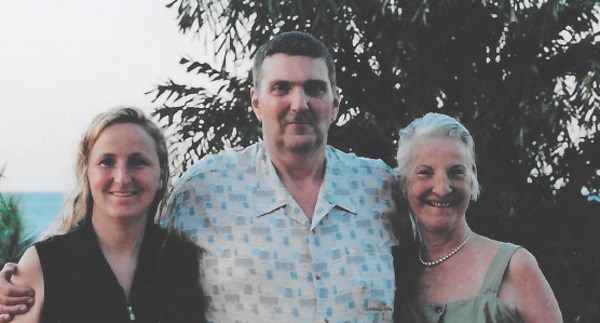With Remembrance Day approaching, it’s important to honour the memory of not only the men who fought overseas in Canada’s wars in the army, navy and air force, but also the many women who left then-traditional female roles in the 1940s to work in the munitions factories to support the Allied war effort.
Sault Ste. Marie’s Sue McComb (nee Fioramanti) left her hometown as a 20-year-old woman in 1944 to work for Victory Aircraft in Malton, Ontario (now part of Mississauga in the Greater Toronto Area).
There, Sue worked as a riveter, playing a vital role in the building of the legendary Lancaster bombers used by British and Canadian air forces to pummel the enemy in the Second World War.
“There were so many women at the time who met the challenge of the war,” said Sandra Greef, Sue’s daughter.
Sue passed away in 2009.
“It took a special touch and patience to line up the rivets,” Sandra said.
“It had to be perfect. The flight crew’s lives depended on it.”
“It generally took two people, one on either side of the metal sheets which formed the fuselage. That type of riveting was strong, reliable and required precision. Mom enjoyed working with a good partner. As a riveter she had to communicate with her partner on the other side to make sure they worked simultaneously,” Sandra said.
In 1944, when Lancaster production was at its highest, one Lancaster per day was completed.
By the end of the war Victory Aircraft had built 420 Lancaster bombers.
Before leaving town to work on the aircraft assembly lines, Sue worked at Algoma Steel as a labourer beginning in 1943, shovelling coal at the plant because of the labour shortage caused when so many men volunteered to serve in the war overseas.
“She said there were only two men in the crew, and they commented on how quickly she was able to shovel coal, as good and as quickly as them. There were many labour jobs available for women, women were quite strong and if they were young women, they were able to do these things,” Sandra said.
Sue, one of 11 children, with her brothers Joe and Sam in the Canadian Army, her sisters Rose and Carmel starting families and her widowed mother raising the younger children, left Sault Ste. Marie for a good-paying job at Victory Aircraft.
“I would say she was always worried about her brothers in the army at the time but she had a job to do, I guess you push those things to the back of your mind, do your duty and what’s expected of you,” Sandra said.
“The money that was being offered (at Victory Aircraft) was pretty good, and she would have sent some home to her Mom.”
Sue also left town with a sense of adventure, Sandra said.
“She was seeing something new and getting out of the Sault.”
“Toronto was a big metropolis for women, she met new people and it was a great adventure for her. She enjoyed it and she was so happy to be able to do something for the war effort here at home in Canada.”
“It was an exhilarating challenge to go out and work, especially on aircraft,” Sandra said.
The roles women were allowed to work in during the war, Sandra said, were a source of liberation for women like her mother.
But it wasn’t all work.
Sue had fun as well.
“She used to talk about ‘the girls.’ They used to go out dancing at night and sometimes they used to have dances at lunch time at Victory Aircraft, to relax and release any pent up energy because they were sitting or standing for long periods of time. She always loved dancing,” Sandra said.
After the war’s end, Sue worked as a restaurant server in Toronto for a brief period of time before returning to the Sault and marrying Bill McComb (a Second World War navy veteran, who passed away in 1994).
Victory Aircraft was later sold and renamed A.V. Roe Canada, the company which, in the late 1950s, worked on the technically-advanced but short-lived Avro Arrow jet fighter project for Canada
“For me, looking back, realizing she was in the same hangars where the Lancasters were built means a lot,” said Sandra, who went on to pursue her own passion for aircraft.
“Being a woman in aviation too, if it wasn’t for my Mom and those other women building planes, I don’t know if I would be doing what I’m doing.”
Sandra became a pilot and now works as a senior flight coordinator for the Ministry of Natural Resources and Forestry (MNRF) in the Sault’s Roberta Bondar Place.
Previously, when in B.C., Sandra was working at an airshow in Abbotsford and saw a preserved Lancaster (one of two ‘Lancs’ left which still fly in airshows, one being based at the Canadian Warplane Heritage Museum in Hamilton, Ontario, the other in the United Kingdom).
“It’s important to me to remember her efforts in the Second World War, for doing the job she did in building aircraft that were shipped over to England to be used by the Allies. She was someone from the Sault, and there may have been other women from the Sault that I’m not aware of who built the Lancasters, they built the aircraft that went over there, and I think that’s just splendid,” Sandra said.
“Women were called on for a short period of time, then when the war ended, they went back to their normal duties and kind of blended back in, so we need to remember the contributions women made on the home front, in the factories or in the forces.”
“I’m very proud of her. My Mom and I were always very close and I always loved her stories, how she shared her past with me so I can share it now in the present.”
